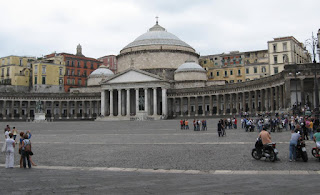If you go to Naples for the day while staying in Sorrento,
spend some time in the area around Piazza del Plebiscito, where there are many
buildings with royal connections that are well worth seeing.
You can arrive by boat and quickly walk up from the harbour
to this area, which is the smartest part of the city.
 |
| Piazza del Plebiscito is not far from the port |
The impressive Palazzo Reale at the eastern end of Piazza
del Plebiscito was one of the residences of the Kings of Naples at the time the
city was capital of the Kingdom of the Two Sicilies.
The palace, which dates back to 1600, is now home to a
30-room museum and the largest library in southern Italy, which are both open to the
public.
It is nice to browse in the shops of the elegant Galleria
Umberto I nearby, which was built in the 1880s and named after one of the Savoy
Kings of Italy.
You could pause for refreshments at Gran Caffè Gambrinus, founded in 1860 in Piazza Trieste e Trento. It was later remodelled
in stile liberty (art nouveau) and became a meeting place for artists and
intellectuals in Naples.
Close to the royal palace is one of the oldest opera houses
in the world, built for a Bourbon King of Naples.
Teatro di San Carlo was officially opened on 4 November in
1737, way ahead of La Scala in Milan and La Fenice in Venice.
 |
| Palazzo Reale viewed from the Caffe Gambrinus |
Built in Via San Carlo close to Piazza Plebiscito, Teatro di
San Carlo quickly became one of the most important opera houses in Europe and
renowned for its excellent productions.
The theatre was designed by Giovanni Antonio Medrano for
Charles I, and took just eight months to build.
The official inauguration was on the King’s saint’s day, the
festival of San Carlo, on the evening of 4 November. There was a performance of
L’Achille in Sciro by Pietro Metastasio with music by Domenico Sarro, who also
conducted the orchestra for the music for two ballets.
This was 41 years before La Scala and 55 years before La
Fenice opened. San Carlo is now believed to be one of the oldest, if not the
oldest, remaining opera houses in the world.
Both Rossini and Donizetti served as artistic directors at
San Carlo and the world premieres of Donizetti’s Lucia di Lammermoor and
Rossini’s Mosè were performed there.
In the magnificent auditorium, the focal point is the royal
box surmounted by the crown of the Kingdom of the Two Sicilies.Look for hotels in Naples with venere.com
Home
No comments:
Post a Comment